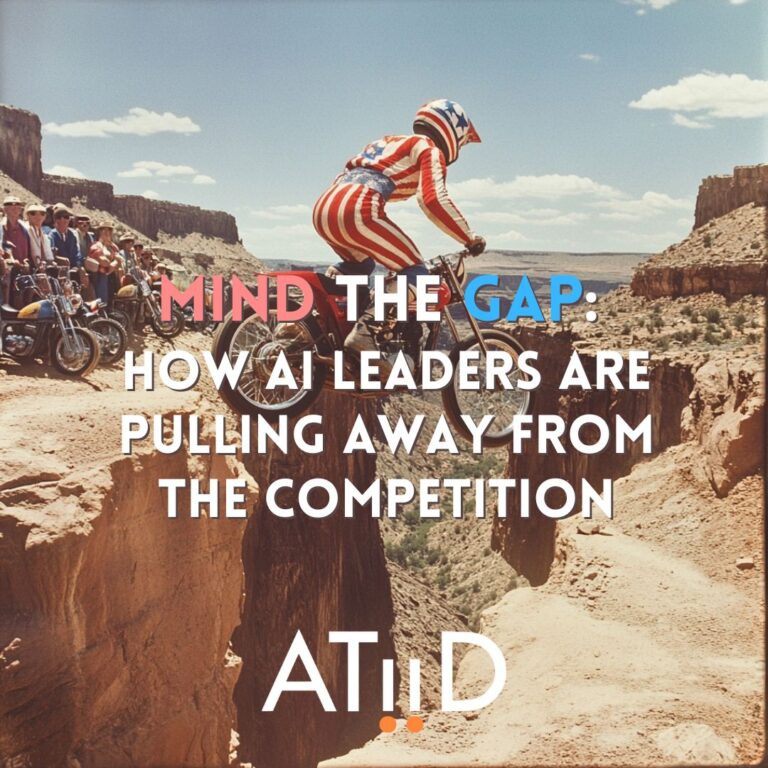Mind the Gap: How AI Leaders Are Pulling Away From the Competition
Middle-market companies that strategically invest in AI are seeing substantial profit advantages compared to industry peers. AI isn’t just the future, it’s the present, evolving faster than most leaders adapt. Over the next 24 months, artificial intelligence will transform industries, reshape business models, and create a significant competitive divide between companies that embrace AI and those that hesitate.
The organizations that act now will build a formidable competitive advantage, while those that delay may find the distance between them and their competitors increasingly difficult to overcome. The question facing you today is straightforward: Will your company lead your industry, or will you scramble to maintain relevance as competitors advance?

Your Competitive Timeline
AI is advancing rapidly, and businesses are integrating it into various operations. A recent McKinsey survey found that over three-quarters of respondents’ organizations use AI in at least one business function. This widespread adoption is reshaping industries and setting new standards for efficiency and innovation.
Here’s what middle market leaders need to prepare for:
- Near-term (12-24 months): AI-powered automation will substantially reduce operational costs for early adopters while others continue managing manual processes and legacy systems.
- Mid-term (2-5 years): Customers will expect sophisticated, personalized experiences that only AI can efficiently deliver, as demonstrated by manufacturers like Midwest Precision that improved customer retention after implementing AI-driven personalization, while competitors like NorthState struggled with market share.
- Long-term (5+ years): Advanced AI assistants will support critical business decisions alongside executives at leading companies, processing information at a scale human teams cannot match.
- Ongoing: The data advantage becomes increasingly significant. AI leaders will operate with predictive precision while followers remain trapped in reactive business models.
The Widening Gap: Leaders vs. Laggards
Companies that embrace AI are not just improving—they’re pulling ahead in ways that may be hard to match. For instance, NIB, a health insurer, saved $22 million by implementing an AI-driven digital assistant, reducing the need for human customer service support by 60%. On the flip side, companies slow to adopt AI are finding themselves at a competitive disadvantage.
Middle market companies that embrace AI now are creating momentum that compounds over time:
- Immediate Cost Transformation While you deliberate, your competitors are already reducing operational costs, creating cash flow advantages they’re reinvesting in growth.
- Market Share Shifts Companies employing AI-driven marketing and customer engagement are seeing significant improvements in customer satisfaction and retention metrics. Your customers will notice the difference.
- Talent Acquisition Advantage The middle market talent war is intensifying. Top performers increasingly prefer companies with clear AI strategies. Your best people are evaluating their options.
- Technology Investment Escalation Every quarter you delay increases the investment required to catch up. Companies that wait too long will face significantly higher costs with diminished returns.
Where Will Your Company Stand?
The AI revolution represents a fundamental business model transformation that’s distinguishing market leaders from the rest. Middle market executives who embrace AI today are building foundations for long-term competitive advantage, while those waiting for “the perfect moment” risk falling permanently behind.
Leaders who act now will achieve greater operational efficiency, superior decision-making capabilities, and margins their competitors struggle to match. Those who hesitate will face difficult choices: expensive transformation with uncertain outcomes, or gradual market erosion.
Your 90-Day AI Leadership Path
The impact of custom LLMs varies dramatically by industry, creating unique competitive opportunities:
1. Conduct an AI Readiness Assessment
Identify your highest-value AI opportunities and quantify their potential impact.
2. Develop Your AI Integration Roadmap
Create a prioritized implementation plan with clear milestones and ROI metrics.
3. Execute Your First AI Initiative
Launch a focused pilot that can demonstrate value quickly, building momentum and organizational confidence.
The AI revolution isn’t slowing down, and the companies that act now will be the ones shaping the future. Waiting too long to adopt AI isn’t just a missed opportunity, it’s a risk that could leave your business struggling to catch up. AI leaders are already reducing costs, improving efficiency, and gaining a serious competitive edge.
The question is: Will you be one of them?
At ATiiD, we help businesses future-proof their operations with AI strategies that drive immediate impact and long-term growth. Contact us today for your AI Readiness Assessment and take the first step toward securing your company’s future.
